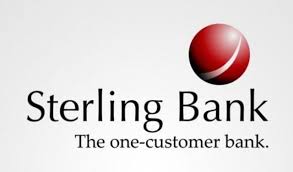
Equity analysts at Meristem Securities Limited have forecasted price target of ₦1.43 following a disappointing earnings in the first half of 2020.
Traded at ₦1.14 kobo on Thursday, investors valued Sterling Bank at ₦32.821 billion on 28,790,418,126 shares outstanding.
In its equity note, analysts stated that Sterling Bank’s overall topline performance remained pressured in the first half of 2020, following its weak outing in the first quarter.
However, Meristem advised investors to buy the stock at market price, resulting to 25.44% upside despite the downgrade.
A marginal growth of +0.79% year on year in Q2:2020, however, moderated the decline in topline to 2.85% in H1:2020, from 6.67% YoY in Q1:2020.
Lender’s first half result showed about 3% decline in gross earnings as a result of a 4.5% year on year decline in interest income.
Gross earnings dropped from ₦72.3 billion in the first half of 2019 to ₦70.2 billion a year after.
Interest earnings assets yielded ₦59.5 billion in H1:2020 from ₦62.1 billion while interest expenses reduced significantly.
The 18.1% reduction in interest expenses reflects a lower interest environment and banks have embarked in deposit reprising.
The bank’s topline which amounted to ₦70.23 billion in H1:2020, was adversely impacted by depressed asset yields which fell to 13.20% from 14.00% in H1:2019, causing a 4.28% year on year decline in interest income.
Also, the lender’s fee-based income sustained its descent, with a 29.70% decline in H1:2020, due to the cut in electronic banking fees.
In the first half of 2020, Sterling Bank’s paid ₦26 billion to providers of funds, this translated to 18.1% year on year decline when compare to ₦31.7 billion paid in the comparable period.
Non-interest income listed the bank’s earning, surged 5.9% to ₦10.8 billion from ₦10.2 billion in the comparable period.
The bank’s trading income (+242.83% YoY growth to ₦3.95 billion) however, continues to benefit from relatively higher prices of bonds and treasury bills in the secondary market.
“We affirm our earlier position that the weak growth in its earning assets is a key risk factor to topline growth for the bank, considering that its interest-earning assets have only grown by 0.66% year to date”, analysts at Meristem stated.
Analysts said given the depressed yield environment, Meristem Securities reckons that a significant growth in earning assets is required to drive growth in topline.
Meristem said it also does not help the bank that 16.66% of its total assets as at H1:2020 is domiciled with the CBN and therefore yields no interest.
“Based on the identified risks and considering that we do not see significant headroom for more trading gains in H1:2020, we review our 2020 gross earnings growth forecast to -4.84% from 1.60% negative”, analyst stated.
Yet More Room for Bottom Line Improvement
Meristem Securities explained that the bank continued to drive down its cost of funds (CoF) by leveraging the low interest rate environment and improving its current and savings accounts (CASA) mix.
“Unlike in Q1:2020, the decline in CoF to 5.00% from 6.50% in H1:2019 translated to an increase in net interest margin to 8.20% from 7.50% in H1:2019.
“However, the gains in net interest income were quickly eroded by significantly higher (+165.83% year on year) loan provisioning in H1:2020”, analysts explained.
In the period, lender’s cost of risk jumped to 2.10% from 0.70% in H1:2019.
Meanwhile, Meristem Securities analysts stated that Sterling Bank’s high impairment charges are broadly in line with expectation so far.
But, Meristem said it expects some moderation in the rest of the year owing to a generally improving business landscape, stable crude oil price and slow growth in loan book.
Despite the higher provisions, the bank achieved a significant improvement in cost efficiency.
In the period, Sterling Bank’s cost-to-income ratio (CIR) fell to 72.60% from 80.30% in H1:2019.
Analysts said the improvement in cost efficiency is however yet to significantly reflect on bottom line performance.
Both profit before tax (PBT) and Profit after tax (PAT) fell by 5.38% year on year and 4.38%, to ₦5.68 billion and ₦5.41 billion respectively.
“We expect lower CoF and a further moderation in operating expense growth to mitigate the impact of high credit loss charges.
“Hence we maintain our projection of a relatively flat bottom line performance”, analysts stated.
Liquidity Position Still a Matter of Concern:
Meristem said although lender’s net operating cash flows improved from -₦62.60 billion in Q1:2020 to ₦35.27 billion, concerns arise from the observation that the largest portion of operating cash outflows were due to increased CRR debits (₦93.45 billion) which are not value accretive.
“We posit that this might be due to the fall in its LDR to 64.30%, which is below the regulatory minimum.
“We expect the bank to place a focus on keeping its LDR above the benchmark to avoid further pressure on liquidity.
“We do not have any concerns over any other prudential metrics as they are within regulatory limits”, Meristem Securities stated.
Meristem Securities said its expectations for full year performance remain largely unchanged, albeit significant growth in earning assets and transactions volumes are considered upside risks to the expectations.
“We maintain our expected earnings per share (EPS) at ₦0.36 while target price earnings is revised to 3.97x from 4.58x.
“This yields a 2020 target price of ₦1.43, indicating an upside potential of 25.44%”, analysts estimated.